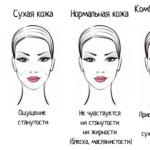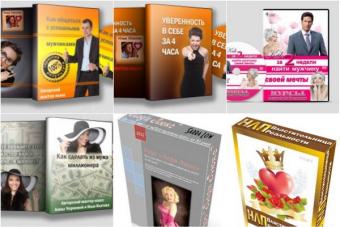Games with earbuds- it's not only interesting activity for the baby, but also a process that helps the development of visual and effective thinking. What can earbuds teach?
Due to what such toy (insert caps, nesting dolls) a set of several objects that have the same shape, but different sizes, the child learns to correlate objects by size, and by putting one object into another, he develops coordination of movements.
Inserts also include toys with recesses and slots where objects that match them in shape and size are placed - sorters.
Games with inserts are most useful for babies after one year, as they develop spatial thinking, coordination of movements, promote color discrimination and correlation of shapes and sizes.
How to choose insert toys?
- For babies over 18 months It is better to choose sets that consist of more than five items. Good choice could be a matryoshka doll with a set of cubes and bowls corresponding to the number and size of objects.
- If you are choosing a toy for an older child, you can pay attention to boxes for molds or flat inserts, and it is better to choose ones where inserting is part of the game process. Such, for example, where the child finds a window corresponding to the shape of the objects depicted on the inserts. Or pictures with objects are parts of a larger picture with their own plot. Such inserts make it possible to create game situations, developing the plot interesting for a child stories or fairy tales.
How to play earbuds with your child?

Inserts allow you to create a variety of games, in which your baby will be happy to participate, simultaneously developing the necessary skills and abilities: fine motor skills, coordination of movements, the ability to sort objects based on shape, cultivate cognitive activity, communication skills and much more...
We wrote about what these toys are and how to choose them correctly for the age of the child. Here.
And now:
Sample educational games with insert toys:
Game "Hide and Seek"
Hollow cubes or any other hollow objects of the same shape and different sizes can be suitable for such a game. Using cubes as an example, the game might look like this. 4-5 cubes are placed on the table on top of each other with their cavity facing down. At first, the baby sees only the largest cube, and then, when you take turns removing them from each other, he will see that another, smaller one is hiding under each cube.
Then, together with your child, you can hide the cubes in reverse order. The game is accompanied by approximately the following words: “What is hiding there? Cube! And here's another one! Let's hide them again. There is no cube, now this is gone too. Again, one cube left! The child will master this game very quickly and will happily hide and look for the cubes. You can help your baby by taking his hand and demonstrating how one block fits onto the other. The number of cubes or other inserts that can be used for “hiding places” can be gradually increased.
"Building a tower"
For this game, cubes are used. Show your child how cubes are placed one on top of the other - a smaller cube is placed at the bottom of a larger cube, etc. You can comment on this construction project with joyful words: “What a big and beautiful tower we have!” The child will probably immediately want to join in and start building the tower himself. Subsequently, this game can be diversified: due to the fact that the cubes are hollow, on different floors of the constructed tower you can hide a ball or another small object that is so interesting and joyful to find. This game will help develop coordination and attention.
"Place it in its place"
IN early age Children are very fascinated by the process of putting different objects into containers. Inserts can make this process more interesting and educational. Here's how you can make it happen. All elements from the set of inserts (bowls, hollow cubes, etc.) are arranged in a row from largest to smallest. Having shown the child once that all items are placed in containers so that not a single one is left unfilled, you can give him the opportunity to do this on his own. After your baby learns to fill all the bowls by placing one item in them, you can begin to show him how the item corresponds to the size of the container: in a large bowl - a large ball, in a small bowl - a small one. Subsequently, it will no longer be difficult for the child to fill the containers with objects that match them in size.
A game for several children with an insert board “Windows and lids”
An insert board may be interesting for older children. With its help, you can organize a joint game for 3-4 children aged 2.5 years. Place the guys at the table on which the figures are laid out different shapes, and give each of them a card on which a relief outline corresponding to one of the figures is applied. First you need to let the kids carefully look at their cards and touch them. Invite each child to trace the outline on their card with their finger. After this, turn to one of the children: “Masha, look, what kind of lid can you use to close your window?” Even if Masha does not immediately find a suitable shape, there is no need to say that this lid is not suitable. Check the figure with your children and make sure they have chosen the wrong one. When a suitable lid is found, rejoice, demonstrate the achievement to all the children, have Masha open and close her window several times. When all the children manage to do this, you can invite them to exchange cards with windows. This game can be continued for as long as the children find it interesting.
You can play the game “Windows and Lids” with one child, replacing the cards one after another and, as you master the game, complicate it, offering more and more new figures.
Matryoshka dolls allow you to come up with a variety of games that will be interesting to both one child and a group of children. Here are examples of such games:
"Let's get to know each other"
For the game, a matryoshka doll of 10-12 elements is used; if one is not at hand, then two five-seater dolls can replace it. The essence of this game is the first acquaintance with this wonderful toy, so that the child discovers its main secret. Having settled down next to the baby, take out a new toy, make her happy with the appearance of your baby: “Look how beautiful your new toy! What a beautiful handkerchief she has, what rosy cheeks!..” Then take her in your hands and say in surprise: “The nesting doll is heavy, it’s rattling, let’s see, maybe it has something inside?” When opening a nesting doll, you can say something like the following words: “Matryoshka, show yourself to us a little,” “Open up, matryoshka, show yourself to us a little.” When you and your child are surprised that there is another one in the nesting doll, look at both nesting dolls, ask the child to show which one is big, which one is small, what color their aprons and handkerchiefs are. Tell us that the shape of the nesting dolls is the same, but they are different in size. Thus, take out all the nesting dolls one by one, compare them, look at them, and line them up by height. After your baby has become acquainted with the nesting doll, you can proceed to the next game - “Kindergarten”
"Kindergarten"
Tell your child that nesting dolls, just like children, go to kindergarten. Large nesting dolls go to the older group, and small ones to the younger group. Having divided the table into two parts, which will be two groups, ask the child to take each of the nesting dolls to his own group. If the child gets confused, put the nesting dolls next to each other and ask which one is bigger and which one is smaller. When all the nesting dolls are in their own groups, it is worth noting once again that large and small nesting dolls are in different groups. You can complicate the task by collecting nesting dolls for a walk. Let the baby first build them according to height, and then the large nesting dolls will find a pair among the small ones: the largest nesting doll from senior group will choose the largest from the youngest and so on. Couples who have found each other go to the playground, to the other end of the table. When all the nesting dolls have gone for a walk, they can play hide and seek. Note once again for the baby that only the matryoshka can hide in the big one. shorter. In the game “Kindergarten” you can come up with many different plots: nesting dolls can go to the nurse to measure their growth, you can select plates for their lunch according to their sizes, select beds for them to sleep in, etc. The main goal is to convey to the baby that all nesting dolls are different from each other, but at the same time they are similar - they can be girlfriends or relatives.
The two games above show that you can play with nesting dolls to create the most different situations, which will not bore the child.
And finally, a few more general recommendations for organizing educational games with inserts for a child:
- do not leave the matryoshka in free access for a child until he begins to meaningfully play with it, otherwise the toy may quickly become boring and it will be more difficult to obtain the expected benefit from it;
- The first games with a matryoshka doll are best played with your participation, with emotional and imaginative participation, try to make the games as expressive as possible.
- Your participation does not imply a restriction of freedom for your baby, on the contrary, encourage him to think and take active action. Do not correct incorrect actions yourself, it is better to refer to the right decision leading questions. That is, the purpose of your participation is to help in mastering an exciting toy. And you can see the results of such games very soon after you start getting acquainted with the new toy.
The online store offers inexpensive purchase of frame inserts different types, designed for various age groups. This is an effective educational toy, which is a tablet with slots in which inserts are inserted that completely match the shape of the slots. The essence of the game is to remove the inserts from the frames and then insert them back.
While playing with frames, kids:
- develop fine motor skills, coordination of movements, sensory perception;
- understand the relationship between part and whole;
- enrich their understanding of geometric shapes Oh;
- expand their understanding of the world around them;
- learn to classify objects, establish connections between objects and phenomena.
You can use this educational toy not only at home, but also in kindergarten. When communicating with a child, it is advisable to carefully prompt him, help, but not impose your help, or solve the problem for him. Communication between a child and a parent or teacher during play helps develop speech and enrich lexicon.
Montessori frames
Maria Montesori was the first to use such toys for child development, noting that children like to select objects according to size and shape. Our store offers a wide range of Montessori frames for children of different ages - from materials used at the very beginning of learning to more complex aids.
Monessori frames can also be used to teach writing, drawing and drawing. To do this, you need to invite the child to trace the liners along the external and internal contours and shade the resulting images.
Buy educational frames various types in the online store "Early Start"! Our catalog contains both frames with geometric shapes and toys with slots of more complex shapes depicting fruits, animals, and transport. You can order products at an affordable price via the Internet; we deliver throughout Russia, Ukraine, Belarus and Kazakhstan.
Insert frames is a multifunctional educational toy for children from several months to 5-6 years. The main principle of the game is to insert figures (inserts) into correspondingly shaped recesses (frames). During this exciting activity, your baby will develop fine motor skills, spatial thinking, memory and attention, learn to relate objects by shape and size, expand his vocabulary and horizons. By observing the speed and quality of completing a task, you can trace the path of the child’s intellectual development and progress in his learning.
In our online store you can buy frame inserts different types. For babies from 8 months old, boards with figures are suitable, or Seguin boards. The toy is a tablet with recesses into which figures of various shapes, sizes, colors, themes (for example, fruits, vegetables, animals, etc.) are inserted. Each insert consists of one or more parts and has a special handle or edges protruding above the surface of the tablet to make it easy to remove from the frame. Montessori insert frames are made in a similar way, but this toy is two-stage: the geometric inserts are not inserted into a common tablet, but into separate square plates. Games of this type teach the child to determine the shape of an object by sight and touch, with eyes closed, help him practice the mechanical skills of returning the liners into place, and introduce him to the standards of geometric shapes. Figures can also be traced on paper and shaded to prepare a child’s hand for writing.
Another type of wooden frame-inserts, suitable for children from one year old, is puzzles. The child is offered a picture, cut into several fragments and folded into a common frame. Sometimes there is a colored sublayer as a hint: on the tablet, under the inserts, the same picture is drawn, but with missing details (people in a car, rooms in a house, etc.). By assembling a puzzle, the child will become familiar with the concepts of “part” and “whole”, develop combinatorial abilities, learn to navigate a plane and reproduce an image from memory. At first, you can ask your child to simply complete the picture with the missing details, and over time he will be able to assemble it entirely on his own.
A kind of inset frame for children from 1.5 years old are games where select a wardrobe to some character: “Dress the family of bear cubs”, “Change the boy’s clothes” and others. This is not only an interesting, but also an educational activity, during which your baby will get acquainted with the names of items of clothing, learn how to choose a suit according to the weather and the occasion (dressy, for a walk, for sleep). Girls will especially like this game, because it is so similar to paper dolls!
In this section you will also find wooden mazes. The figures need to be led along winding paths and placed in their places (for example, place baby animals next to their mothers). This game especially actively develops spatial-logical thinking, perseverance, speech and knowledge of the world around the child.
Most insert frames are made of well-treated wood, but there are also toys made of soft foam material - flexics. The latter are perfect for playing in water, as they stick to smooth tiles and bathtub walls.
Educational insert frames are toys for children from 8 months. At this time, children's curiosity begins to gain momentum, and the baby quickly tries to learn the world. Insert frames will help him significantly enrich his knowledge about the objects and phenomena around him.
What are children's frame inserts?
Frames with inserts are made primarily of wood. They are flat tablets with recesses of different shapes and sizes into which inserts are inserted. The essence of the game is to choose the right “house” for the insert. It seems to be very simple, but for a child this is a real puzzle game! Fingers and hands, visual receptors (eye sensor), thinking, and logic are actively involved in the work. Inset frames have another secret for their great purpose :) For novice users, the insets have small handles and buttons. They are made not only for convenience, but also for training the 3 main fingers of the hand - thumb, index and middle. These fingers are involved in the future in the writing process, and thus the hand is indirectly prepared for writing.
Which inlay frame should you buy for your baby?
If you are between 8 months and 2 years old can choose wooden inset frames from the "More-Less" series And Educo. They suitable for the first acquaintance with this type of educational toys. Also, up to 2 years old, simple frames with 2-3 inserts with hidden pictures will be of interest. At this age, you need to teach your baby to take out the insert and find its “house” by trying on the shape and size of the recess through trial and error. With this we train the eye and develop coordination of movements. If you are between 2 and 3 years old , then here you need to interest the baby with bright and colorful insert frames, where he will meet familiar animals, favorite toys or objects and things seen in life. This series includes frames "Who lives where?", frames with geometric shapes, designer frames with animals , multi-piece puzzle insert frames and art frames. Artistic insert frames offer not only the correct placement of the inserts, but also the outline of them and the completion of the resulting figure. If you are already 3 , then it's time to meet with counting, numbers, fractions, time and complex geometric shapes. Educational frames-inserts made of natural wood with funny colorful patterns will perfectly cope with this task. Addition and subtraction puzzles, funny numbers and clocks will make it easy and relaxed to introduce your child to counting and the concept of time.
We also have a selection of classic Maria Montessori smart frames, which formed the basis of all currently existing children's insert frames. You can choose Montessori frames according to the level of complexity according to the age of the child.
Developmental value of frames with inserts
Toys inset frames acquaint the child with sensory standards of form, develop the ability to visually and by touch recognize and distinguish the shape of flat figures and their location. In the game, the baby trains optical-spatial thinking, observation and attention. Feeling, tracing the liners along the contour and shading improve coordination of movements, develop fine motor skills of the hand, and effectively prepare the child’s hand for writing.
The idea of inset frames, first implemented by Maria Montessori, turned out to be so ingenious that it was picked up and expanded by many authors around the world. Now there is a huge variety of toys with the general name “frame inserts”. How to play them?Insert frames are very diverse. They differ from each other in shape, theme, age purpose, technical design (for example, wooden frames-inlays). Whatever the toy, the main thing is that it brings great benefits to the baby. The main task of the game is to return the cut out small part to its place, after first matching the shape and size of the element and the “house” for it. In some toys, it is possible to navigate by the meaning of the picture, while in others, shape and size are the only defining characteristics. Interesting, isn't it?
Let's start playing with frames
Introduce the baby to this interesting toy maybe even up to a year. The child will need the simplest frames, for example, with geometric shapes. It would be great if the toy is made in contrasting colors. Trace the contours of the figures with your baby’s finger, comment on the actions, try to put the figures together in the “houses”.

After a year, give the little one the assembled one, and let the little one try to take it apart on his own. This is very good for a baby hard work, so encourage and praise your child. In order to master creative actions, you must first learn to destroy.
By the age of two, your little one will be able to assemble simple frame inserts very quickly. Move on to more complex options. Don't think that taking out the figures and putting them back is an activity for the little ones. Insert frames will be interesting for children and older people.
Game options with inset frames
When your child is already confidently assembling a frame, and he is getting bored with this activity, try offering him new interesting ways of assembling:
- with eyes closed;
- left hand;
- two hands at the same time (both hemispheres of the brain develop well);
- toes (excellent prevention of flat feet);
- take turns with you;
- for speed: who is faster, each taking a frame with the same number of elements;
- for a personal record (to make it more clear, turn every second into a square and build a record tower, explain that the smaller the tower, the faster your kid worked, let him now try to reduce his own tower). Thus, the child will gradually learn to set goals and objectives and achieve them;
- fix errors in your build.
Come up with different stories to give the activity of putting details into a frame an interesting meaning. For example, geometric figures is a cookie, and the insert frame is an animate creature named Frame. The child will be interested in feeding Frame, putting food directly into her tummy. Or the frame will be a house for animals, which are depicted in small details. Or maybe it will turn into a boat that the numbers will want to ride on.

You can play with the insert frame and teach the baby. Offer to place all the elements in the frame one by one, and the order will be determined: by the number of syllables (first all words from one syllable, then from two, three, etc.), by the number of letters, sounds, by alphabet.
What are the benefits of games with inset frames?
- Development fine motor skills and finger muscles. The need to take small parts with your fingers, rotate them, adjusting them to the “house”, insert them into the frame, and for the most small child even getting small parts out of the insert frame - all this perfectly develops the fingers and prepares the hand for writing. The baby is playing, but school is going on! Isn't this the dream of all parents!
- Improving hand-eye coordination. The child learns to visually evaluate and compare shapes and sizes, matching them to each other. For a baby, putting a round figure in a cell of the appropriate shape is an achievement.
- Memory development. First of all, visual. The ability to remember images will make it much easier for a child to learn anything.
- Development of attention and perseverance. Naturally, if the baby is not attentive, he will miss the desired cell and the cow will not find its house, and the triangle will try to get into the house of the square. To prevent such confusion, the baby will have to concentrate and not be distracted from what he is doing. The ability to pull yourself together while solving a given task is one of the basic skills that determines a child’s school maturity (link to article on readiness for school).
- Formation logical thinking . By assembling and disassembling frame inserts of various topics, the baby will compare, contrast, combine, classify, find similarities and differences, and therefore learn to think logically.
- Expanding knowledge about the world around us, general erudition. In order for the child to increase his erudition by playing with inset frames, parents should make sure that the range of toys is quite diverse thematically and is constantly replenished with new inset frames on topics that have not yet been studied.
Try assembling one of the insert frames yourself and listen to how you feel when the part falls exactly into place. Isn't this a victory? It is pleasant not only for adults, but also for children to feel that everything is working out. Give your little one self-confidence!





